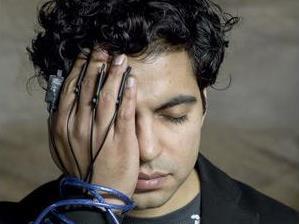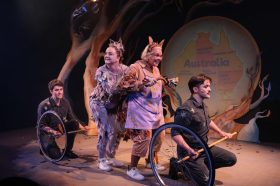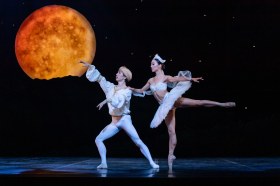Acclaimed Australian pianist, Zubin Kanga. Image via Western Australian Academy of Performing Arts.
Cyborg Pianist is an extraordinary sound adventure evoked by virtuosic piano playing and a blend of video, pre-recorded sounds and live electronics. Zubin Kanga, a young UK based Australian pianist trained at the London Royal Academy of Music, treated a small Perth audience to his extraordinary musical and audience skills whilst premiering works from a number of new music composers both international and Australian. The concert is billed as ‘music that expands the piano using video and electronic, drawing on sci-fi, horror and thriller genres, and utilising found footage (and music) these works explore new ways in which a live musician and technology can interact’. And in fact, that is exactly what happened.
Kanga’s risk taking in providing the range of first time compositions is well founded in a solid base of skilled musicianship and audience interaction and Kanga has a long history as he has premiered more than 60 new works. He has collaborated with Steve Reich, is a member of Ensemble Offspring and is a winner of the Limelight Award for Best Newcomer. Kanga bothers to explain the references that the music alludes to and explains what we might expect, so that rather than new music potentially alienating people, he brings us along for the ride. Of course, having jump cut spooling Hitchcock edits on the big screen helps to gain the attention of those audience members who might zone out. And in fact that’s my only small complaint; that the video images at time do distract from the music. However they are so seamlessly integrated, that it brings a new awareness as to how sound and images work together – alas the fact that most of us blindly consume these two mediums simultaneously during our movie going lives, but outside of that, fail to perceive the emotionality and constructed narrative that music brings to the moving visual image.
The first piece was a thought provoking world premiere of Frontier for Piano, Electronics and Video by Australian composer Marcus Whale which explores the notion of alternatives of early Australian history. This idea of how ‘containing the landscape’ may not have always worked integrates hypnotic video of the Snowy Mountains in speeded up green jagged edges which morphs into super slow calming swoops over the rock, dirt and green shrubs.
We heard the world premiere of Australian composer Damien Ricketson’s The Day after Drowning for Piano and Live Electronics, which is a type of deconstruction of Erik Satie’s Gnossienne No. 1. There are distensions to the original and the resonances of the piano is used to create effects that may replicate the composer’s self-described ‘hearing the original Satie being played from the floor of the ocean’. It was evocative, mournful, wild – with some echoes of whale song – but offered points of grounding to anyone familiar with some classical repertoire.
Johannes Kreidler is a Berlin based composer doing interesting things on YouTube (Kanga describes him as an urban hipster doing high concept work) whose work Study for Piano, Electronic and Video was an Australian premiere.
Another highlight was the Australian premiere of UK composer Adam de la Cour’s Transplant the Movie! For Piano, Electronics and Video, which had members of the audience laughing. Yes! In a contemporary classical music concert. A series of canonical piano works by Beethoven, Chopin, Scriabin, Bartok, Debussy etc. accompany a horror film whose central idea is of juxtaposing hands of a pianist after an accident. The innovative use of music and image is timed perfectly in this piece. There is clever use of the performer on stage and on screen as well as gently puncturing of tropes both in horror movies but also classical music.
The 2014 work by Patrick Nunn Morphosis for Piano, 3D Sensors and Live Electronics was a show stopper. Kanga played with and against the live electronics engineered by Benjamin Carey. It was both beautiful and incredibly fascinating as the electronic sensors (that took him 9 months to program) attached to the performer’s hands function as gravimeters and accelerometers so that aspects of 3D movement can be mapped and thus trigger live electronics through the movements of the pianist’s hands and arms. At times Kanga was balletically performing arm movements that were complementary to the evocative sounds of the piano work. The fluidity in this work was compelling.
Zubin Kanga continues with recitals in Melbourne and Sydney and deserves a far larger audience that would, as we did, appreciate the dexterity, the humour and the intelligence that is applied to creating such a performance as Cyborg Pianist with seamless integration of technology and brilliant musicianship. These compositions are a true extension of the capabilities of the pianist in an exciting dynamic way. Get out to see him next time he performs.
Rating: 4.5 stars out of 5
Cyborg Pianist
Solo Piano performed by Zubin Kanga
With Live Electronics by Benjamin Carey
With compositions by:
Marcus Whale
Damien Ricketson
Johannes Kreidler
Neil Luck
Adam de la Cour
Nicole Lizee
Patrick Nunn
Kate Moore
WA Academy of Performing Arts Music Auditorium 4 October 2016
Melbourne Recital Centre 11 October 2016
Sydney Conservatorium of Music 22nd October 2016





